Observation of a hidden state in a superconductor diamond quantum hybrid system
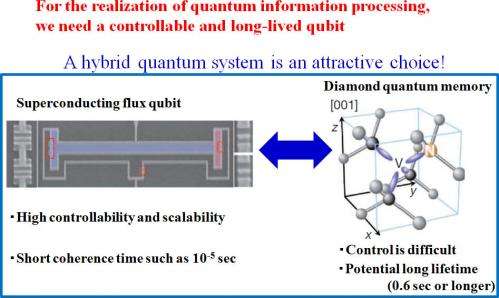
NTT, in conjunctions with its partners from the National Institute of Informatics and Osaka University, observes a hidden long-lived quantum state in a hybrid system composed of a superconducting flux qubit and an electron spin ensemble in diamond.
Since this technology provides a new approach to realize long-lived quantum memories, our results have a potential to reduce the resources and development costs to construct a scalable quantum computation, and therefore our results could make a breakthrough to realize ultra-fast quantum information processing in the future. Our results will be published in Nature Communications on April 8.
This research is granted by the Japan Society for the Promotion of Science (JSPS) through the Funding Program for World-Leading Innovative R&D on Science and Technology (FIRST Program), initiated by the Council for Science and Technology Policy (CSTP). This research was also executed under the Commissioned Research of National Institute of Information and Communications Technology (NICT), Japan.
1.Background
A quantum bit (qubit) is a basic element to build a quantum computer. There are a number of schemes to realize a qubit, how to store quantum information in it, and how to implement quantum gate operations. Among the candidates to realize quantum information processing, a hybrid approach to combine different quantum systems to realize a quantum device has been paid significant attention by many researchers, due to the potential advantage to combine the best properties of the individual systems. So it is believed that a coherent coupling between different quantum systems would be essential for a practical application of quantum information.
NTT, NII, and Osaka University succeeded in 2011 to couple a superconducting flux qubit and a spin ensemble in diamond (Fig. 1 ). The superconducting flux qubit is known to have an excellent controllability while the spin ensemble has, in principle, a long lifetime. The former system can be a quantum processor to implement gate operations and the latter system is expected to be a quantum memory for the long storage of quantum information.
However, when these two systems are hybridized together, the lifetime of the spin ensemble was not so long as expected due to the existence of Nitrogen impurities in diamond. Although it is known that the lifetime of the diamond memory is improved by reducing the Nitrogen impurities, this approach has a significant drawback as it decreases the coupling between the two systems. Therefore, a new approach to improve the lifetime of the diamond memory without such drawbacks was looked for.
Next, an unknown long-lived state was observed in a superconductor diamond quantum hybrid system (Fig. 2 ). However, there was no theoretical explanation why such a long-lived state was detected in the hybrid system. The mechanism for why this state is long-lived needed to be determined. If we could use this state, it would be possible to make a long-lived quantum memory without decreasing the coupling between the superconducting flux qubit and spin ensemble in diamond. Therefore, it is hoped to understand the origin of this unknown state for the realization of a practical long-lived quantum memory.
2.Results of our research
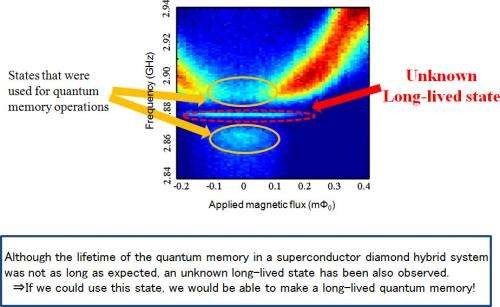
NTT, NII, and Osaka University firstly determined the mechanism for how the state was long-lived. As such, it is an attractive candidate of a quantum memory in a superconductor diamond quantum hybrid system (Fig. 3 ). We have found that this narrow resonance line is direct evidence of a dark state in the hybrid system.
A dark state is usually undetectable in an experiment due to quantum interference that significantly suppresses the amount of a signal from the system to the detector. Although this state is known to be long-lived, it is difficult to use this state for a practical application such as quantum memory if one cannot experimentally detect any signals from the state. We theoretically showed that, in a superconductor diamond quantum hybrid system, the quantum interference of the dark state does not work sufficiently due to magnetic field noise and strain in the diamond. Hence one could observe a signal from the dark state. We experimentally detected such a signal, and showed that the lifetime of the dark state was around 150 ns, an order of magnitude longer than the previous diamond quantum-memory lifetime of 20 ns.
If we could use this dark state for quantum memory, it is expected that the lifetime of a quantum memory would be significantly improved. By combining this long-lived quantum memory with a quantum processor such as superconducting flux qubit, we can reduce the resources and development costs to realize a quantum computer. This quantum technology would provide us with prospects to implement ultra-fast calculation much faster than the current computers can perform.
Experiment to observe a long-lived dark state
- By using a gap-tunable superconducting flux qubit where we can change the energy without decreasing the lifetime, we tune the energy of the qubit at the optimal point to the same one of the spin ensemble in the diamond (Fig. 4 ).
- After applying a microwave pulse on the superconducting flux qubit, we readout the state of the superconducting flux qubit, which provides us with an ability to perform spectroscopy of this hybrid system. The results show that a long-lived state exists in the hybrid system.
- We construct a theory that efficiently simulates a superconductor diamond hybrid system, and succeed to reproduce the experimental results from the numerical simulations (Fig. 5 ).
- We show that a dark state is observed in our spectroscopy from our theoretical calculation. Also, we explain the mechanism that a signal from the dark state becomes detectable in our hybrid system because magnetic-field noise and strain of the diamond weaken the interference effect that the dark state has.
3. Our advances in technology
(1)Technology to fabricate a gap-tunable superconducting flux qubit (NTT).
It is necessary to tune the energy of the superconducting flux qubit with the resonant frequency of the electron spin in diamond for the hybridization of them. However, for this purpose, there is a problem in the previous technology. Energy change of the superconducting flux qubit usually decreases the lifetime so that the quantum properties of the superconducting qubit could be lost quickly, which makes it difficult to hybridize the superconducting flux qubit with another quantum system. NTT research group has a cutting-edge technology of "a gap tunable superconducting flux qubit" whose energy can be tuned with the diamond memory without decreasing the lifetime.
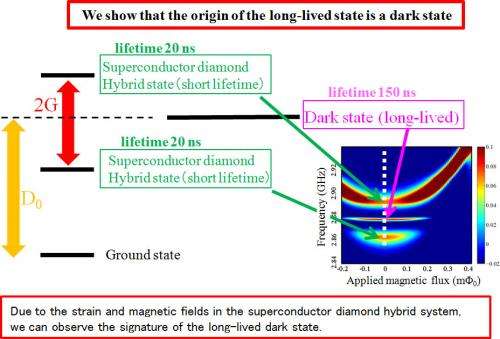
(2)Theory to analyze a superconductor diamond quantum hybrid system (NTT, NII).
It is known that the number of the electron spin coupled with the superconducting flux qubit in the hybrid system is an order of 107, which is too many to be fully simulated by any currently available computers all over the world. NTT and NII research groups have developed a new way to perform an efficient approximation for a theoretical investigation of this system, and we succeed to reproduce the experimental results with a reliable accuracy.
(3)Technology to measure electron spin ensemble in diamond (Osaka University).
In order to hybridize the superconducting flux qubit and an electron spin ensemble in diamond, we need to choose a diamond substrate that has a proper amount of the electron spin density. Osaka University research group has a technology to evaluate the density of the electron spins in the diamond by measuring a photoluminescence with a confocal microscopy.
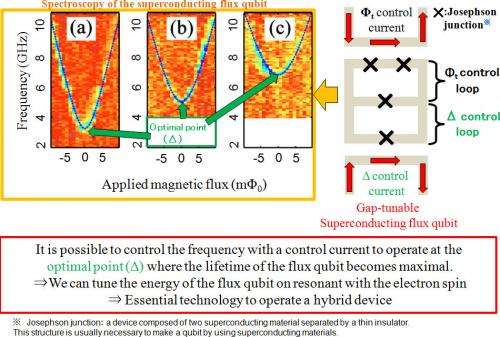
4. Perspectives
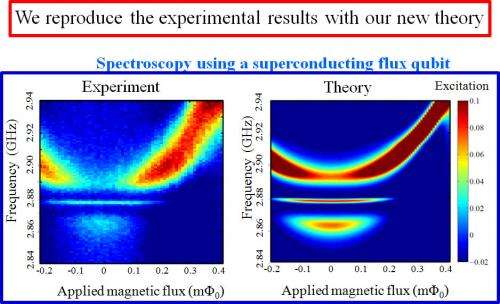
Our initial target is to demonstrate quantum memory operations by using this dark state, and show it can be used to realize a long-lived quantum memory. Furthermore, we aim to construct a scalable quantum device composed of superconducting flux qubits with diamond quantum memories, which is capable of implementing universal gate operations. For such a realization of scalable quantum computation, we continue to improve elemental technology of a superconductor diamond quantum hybrid system.
Provided by Nippon Telegraph and Telephone Corporation